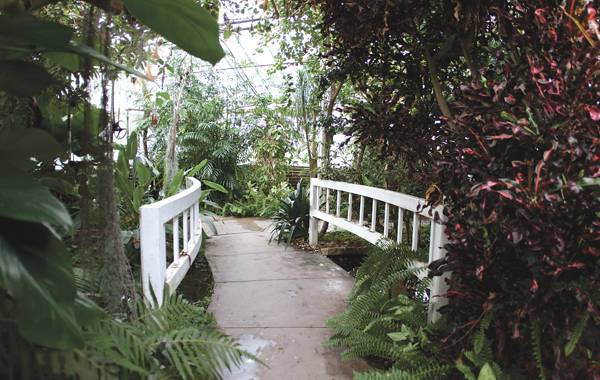Plants to get new digs

Iowa State’s conservatory located in the greenhouse of Horticulture Hall. The conservatory will not be included in the new greenhouses due to budget cuts unless there is a 2 million dollar donation to help fund it. Construction for the new greenhouses is planned to start in May and is scheduled to be completed by fall 2011. Photo: Joseph Bauer/Iowa State Daily
March 2, 2010
Horticulture Hall will soon get a facelift.
That’s because the 18 greenhouses on nearly a one-half acre area will be torn down and replaced with state-of-the-art facilities.
Peter Lawlor, agricultural specialist in the horticulture department and greenhouse manager, said construction on the site will begin in May and is expected to be completed by fall 2011.
“We’ve been talking about it for four years now,” he said. “They’re all approaching 100 years; they’ve all gone past their lifespan.”
The project began with a $6 million budget, but due to budget cuts the project has been allocated $4 million. Because of the loss of the $2 million, Lawlor said there will not be a conservatory in the new greenhouse facility unless the money is donated for the project.
“It’s going to be about two-thirds of the size of what we have now,” he said. “So we’re going to have less space; no conservatory just because of the budget situation.”
The plants inside the existing conservatory will be donated to another conservatory, spread throughout campus or sold in a plant sale, Lawlor said.
“It’s bittersweet because it’s used as a teaching tool and it gets quite a bit of students walking through that aren’t in horticulture,” he said. “But we’re going to have new houses so it’s a tradeoff.”
Lawlor said the greenhouses will be recycled as much as possible and used in the new greenhouses.
“There’s not much we can use though because it’ll be all new equipment,” he said.
The newly constructed greenhouses will feature Web-based controls so Lawlor will be able to check on the greenhouses while off campus. Alarms, fans, a floor heating system and a weather station that detects when snow is present to activate the heat sensors and temperature sensors are also a part of the plans.
Instead of 110-degree summers inside the greenhouses, Lawlor will be able to keep the greenhouses maintained at 75–80 degrees.
“It’ll benefit the researchers a lot because they can have projects they can do a longer-term study under really tight control temperature-wise,” he said.
William Graves, professor of horticulture, uses the Horticulture Hall greenhouses when he researches the conservation, ecology and potential for horticulture uses of rare trees and shrubs.
Graves, who utilizes the greenhouses for research and in teaching a course, said there are safety concerns with the existing structures.
“Really I think there is a safety issue with them,” Graves said. “Structurally they’re not fully sound.”
He said there are times when he and the students have had to evacuate the greenhouses due to windy conditions putting pressure on the structure. He said this could cause the structures to collapse.
Like Lawlor, Graves is excited for the temperature sensors and the environmental controls the new greenhouses will have.
“We’ll have much better control over temperature and light primarily,” Graves said. “Right now we’re nearly totally unable to regulate temperature.”
Graves said the new greenhouses will be used as a teaching tool, both in his course and other courses that involve greenhouse operations and management.
The Horticulture Hall greenhouses are home to 400 species of plants from around the world. Species of bananas, coffee, black olives, mangos and papaya are just a few of the plants that need to be relocated or sold before construction begins in May.
“We’re scrambling for space,” Lawlor said.
Some plants will be moved to other greenhouses on campus temporarily, he said.
Graves said he is finding different homes for his trees and shrubs in other greenhouses, in fields or other outdoor locations. Although it’s a pain to move the plants now, it’ll be better in the end, he said.
“It’s a difficult position we’re in but it’s a short-term sacrifice for a long-term benefit,” Graves said.
Lawlor said the Horticulture Hall greenhouses will remain open for visitors until construction begins in May. The conservatory hours are 8:15 a.m. to 4:45 p.m. Monday through Friday.
















